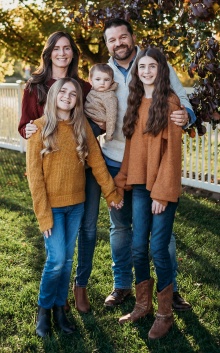Allen Family
From left to right: Lindsey, Adam, Mila, Brier, and Sofia Allen.
Helpful Answers and Support
By Kathy Swenson
Sofia Allen was about three years old when her mother and father, Lindsey and Adam Allen, noticed something was off with her vision.
“Sofia would look above us or to the side of us, but never directly at us,” Lindsey recalls. “We thought she just needed glasses.”
When they went to their eye doctor in central Pennsylvania, however, he noticed clouding and issued further evaluations. After having an MRI and undergoing genetic testing, Sofia was eventually diagnosed with autosomal dominant optic atrophy (ADOA).
“I remember it like it was yesterday,” Lindsey shares. “There was so little information. We felt like we were completely lost and had no one to turn to.”
ADOA is a rare hereditary genetic disorder characterized by impaired vision. It involves progressive damage to the optic nerve. Patients traditionally experience a decrease in sharp vision, blurred vision, reduced contrast and abnormal color vision.
The degree of vision loss can vary from moderate to almost complete blindness. Other symptoms of ADOA include hearing loss and muscle pain and weakness.
“For our daughter and family, the diagnosis affects every aspect of our lives,” Lindsey says. “Sofia has muscle atrophy in addition to being legally blind. The atrophy causes imbalance and therefore she falls often during the day. It impacts her experience at school, her social interactions and her daily activities.”
The Allen family started doing their own research on the condition to support Sofia, which led them to Taosheng Huang, MD, PhD, chief of the Division of Genetics in the Department of Pediatrics at the Jacobs School of Medicine and Biomedical Sciences. At the time, he was professor and director of mitochondrial medicine at Cincinnati Children’s Hospital Medical Center.
“Finding Dr. Huang and learning about his research in this area gave us hope for the first time,” Lindsey shares. “He’s always been very responsive with helpful answers and support.”
The Allen’s founded the Autosomal Dominant Optic Atrophy Association, a nonprofit charitable
organization to raise awareness and help fund medical research to support targeted treatments, and possibly one day, a cure. Along with the Allen’s, the association is composed of five key board member volunteers: Melissa Wertz, Claudia Matheny, Patty Sager, Emma Benjamin and Jacob Wertz, all of whom donate their time and energy to help support the effort to raise awareness and find a cure for ADOA.
To date, they have raised and donated over $100,000 to support Huang’s research at UB and are partnering with him on a $2 million grant application to support optic nerve regeneration.
“Ultimately, this project will allow us to examine how cell-growth signaling pathways such as rapamycin, or mTOR, are altered in optic atrophy. This will provide valuable information for developing new treatments aimed at rejuvenating the optic nerve in patients suffering from autosomal dominant optic atrophy,” says Huang.
ADOA affects approximately one in every 30,000 people. Currently, there is no treatment or cure, but the Allen’s emphasize there is hope—a message they share with other parents and families who reach out to the ADOA Association for guidance.
“I tell them they are not alone and that there’s promising research and advancements for ADOA,” says Lindsey. “We are working really hard to raise awareness among patients’ families and the medical community. We need more doctors to know about ADOA and how to help those affected by it.”
For more information, contact Kathy M. Swenson, senior director of advancement for the Jacobs School of Medicine and Biomedical Sciences, at kswenson@buffalo.edu, or call 716-829-5052. To learn more about the Autosomal Dominant Optic Atrophy Association, visit www.adoaa.org.
